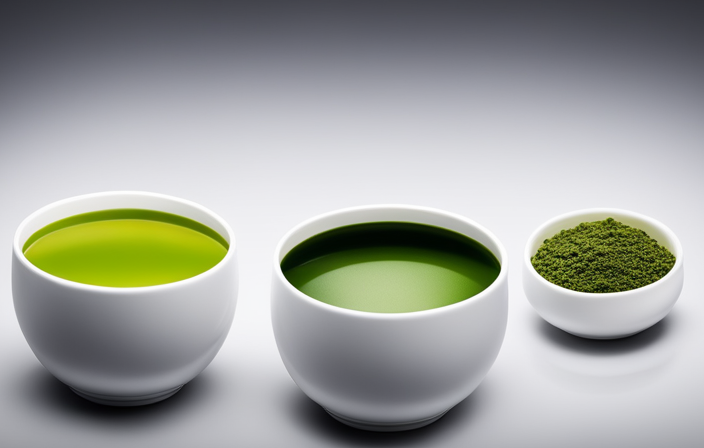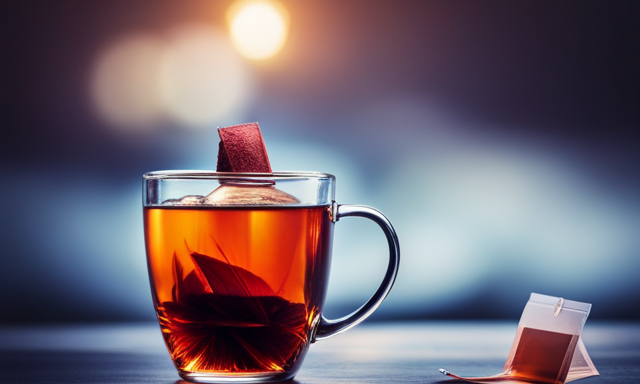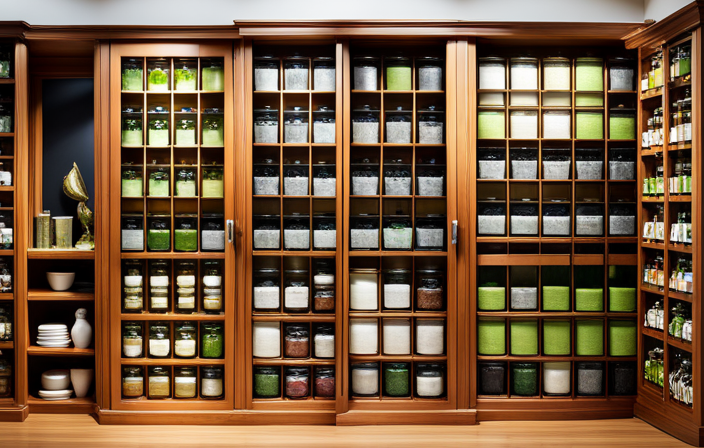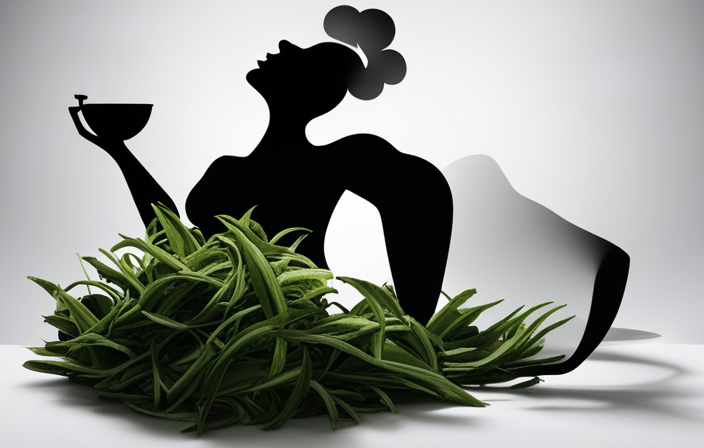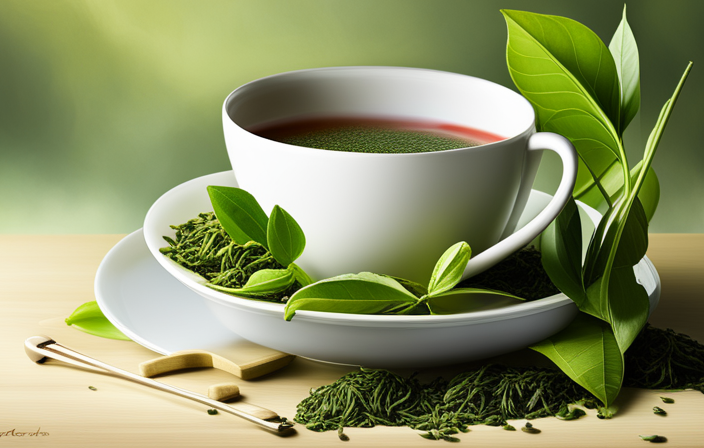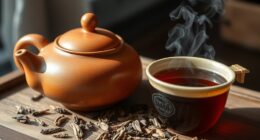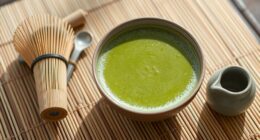Did you know that matcha, a powdered form of green tea, has a stronger flavor and higher antioxidant content compared to regular green tea?
As a tea enthusiast, I was fascinated to discover how the potency and nutritional profile of matcha sets it apart.
In this article, we will delve into the differences between matcha and green tea, exploring its unique characteristics and the benefits of consuming the whole tea leaf.
So, grab a cup of tea and let’s dive in!
Key Takeaways
- Matcha has a stronger taste compared to regular green tea, as it is made by grinding specially grown and processed green tea leaves into a fine powder.
- Matcha has a higher antioxidant content, particularly catechins, compared to regular green tea, which have been linked to improved heart health, weight loss, and brain function.
- Matcha contains a higher amount of caffeine compared to regular green tea, providing a stronger and more sustained energy boost.
- Matcha’s unique cultivation and production process, along with its higher concentration of beneficial compounds, make it a more potent and concentrated form of tea compared to regular green tea.
The Stronger Flavor of Matcha
I can definitely taste the bolder richness of matcha compared to regular green tea. Matcha has a stronger taste due to its unique production process. While regular green tea is made by steeping tea leaves in hot water, matcha is made by grinding specially grown and processed green tea leaves into a fine powder. This powder is then whisked into hot water, creating a frothy and vibrant green beverage. The grinding process intensifies the flavor of matcha, resulting in a stronger taste that’s both earthy and slightly sweet.
In addition to its stronger flavor, matcha also offers numerous health benefits. It’s packed with antioxidants called catechins, which have been shown to reduce the risk of chronic diseases such as heart disease and cancer. Matcha is also known to boost metabolism and provide a natural source of energy without the jitters commonly associated with coffee. Furthermore, matcha contains high levels of chlorophyll, which helps to detoxify the body and support overall wellbeing.
Higher Antioxidant Content in Matcha
Matcha has a higher antioxidant content and provides more health benefits compared to regular green tea. Antioxidants are compounds that help protect our cells from damage caused by free radicals. Matcha contains a type of antioxidant called catechins, which are known for their potent health-promoting properties. These catechins have been found to have a higher concentration in matcha than in regular green tea.
The higher antioxidant content in matcha is believed to contribute to its numerous health benefits. Research suggests that matcha may help boost metabolism, support weight loss, improve heart health, and enhance brain function. Additionally, the antioxidants in matcha have been linked to a reduced risk of chronic diseases, such as cancer and heart disease.
Transitioning to the next section, let’s now compare the caffeine levels in matcha and green tea.
Comparing Caffeine Levels: Matcha Vs. Green Tea
When comparing the caffeine levels of matcha and green tea, it’s important to note that matcha contains a higher amount of caffeine due to its unique cultivation and production process.
This higher caffeine content in matcha can provide a stronger and more sustained energy boost compared to regular green tea.
Understanding the differences in caffeine levels between these two beverages is crucial for individuals seeking specific effects on their energy levels.
Caffeine Content Difference
The article highlights the caffeine content difference between regular green tea and matcha. When it comes to caffeine absorption, matcha takes the lead due to its unique preparation method. Matcha is made by grinding the whole tea leaves into a fine powder, which allows for a higher concentration of caffeine to be consumed compared to regular green tea. However, it’s important to note that the caffeine content alone does not determine the health benefits of a tea. Regular green tea contains a range of antioxidants, vitamins, and minerals that contribute to its overall nutritional profile. To provide a clearer picture, below is a table comparing the caffeine content and key health benefits of matcha and regular green tea:
| Tea Type | Caffeine Content (per cup) | Key Health Benefits |
|---|---|---|
| Matcha | 70mg | Increased energy and focus |
| Regular Green Tea | 30mg | Enhanced metabolism and heart health |
While matcha may have a higher caffeine content, both teas offer unique health benefits that can serve individuals in different ways. It’s important to choose the tea that aligns with your specific needs and preferences.
Effects on Energy Levels
I enjoy drinking both matcha and regular green tea because they provide a boost of energy and help me stay focused throughout the day.
Matcha is a type of powdered green tea that’s made from young tea leaves. It contains a higher concentration of caffeine compared to regular green tea, which contributes to its energizing effects. Additionally, matcha contains an amino acid called L-theanine, which promotes relaxation and mental clarity. This combination of caffeine and L-theanine in matcha helps to enhance focus and cognitive function.
In terms of metabolism, matcha has been found to have a greater impact compared to regular green tea. This is because matcha is made from whole tea leaves that are ground into a fine powder, which means that when you drink matcha, you’re ingesting the entire leaf and all its nutrients. This includes compounds like catechins, which are powerful antioxidants known to boost metabolism and aid in weight loss. Regular green tea, on the other hand, is made from steeping tea leaves in hot water, resulting in a lower concentration of these beneficial compounds.
Overall, both matcha and regular green tea have their own unique benefits when it comes to energy levels, focus, and metabolism. Whether you prefer matcha for its higher caffeine content and potent nutritional profile, or regular green tea for its milder flavor and antioxidant content, incorporating either of these teas into your daily routine can provide a natural and healthy way to stay energized and focused throughout the day.
Understanding Matcha’s Powdered Form
Understanding matcha’s powdered form is crucial in comprehending its unique characteristics and uses.
Matcha, unlike regular green tea, is made from shade-grown tea leaves that are stone-ground into a fine powder.
This vibrant green powder is rich in antioxidants, amino acids, and chlorophyll, which contribute to its distinct flavor, vibrant color, and numerous health benefits.
Matcha Vs. Green Tea
When it comes to brewing, I prefer matcha over green tea. Matcha, a powdered form of green tea, offers numerous health benefits and unique preparation techniques that set it apart from regular green tea.
Matcha is known for its high concentration of antioxidants, such as catechins, which can help reduce the risk of chronic diseases and support overall well-being. To prepare matcha, one must use a traditional bamboo whisk to dissolve the finely ground powder in hot water, creating a vibrant and frothy beverage.
This method allows for the full consumption of the tea leaves, maximizing the intake of nutrients and antioxidants. Unlike green tea, where the leaves are discarded after steeping, matcha provides a more potent and concentrated form of tea, making it a superior choice for those seeking a boost in health benefits.
Nutritional Benefits
There are several nutritional benefits to consuming matcha powder, such as its high concentration of antioxidants and amino acids. Matcha is known for its exceptional nutritional composition, which sets it apart from regular green tea. Here are some key points to consider:
- Matcha is packed with antioxidants, specifically catechins, which help fight against free radicals and oxidative stress.
- It contains a high amount of L-theanine, an amino acid that promotes relaxation and focus, providing a calm yet alert state of mind.
- Matcha is rich in chlorophyll, which aids in detoxification and supports healthy digestion.
- It’s a natural source of vitamins and minerals, including vitamin C, vitamin A, potassium, and calcium.
These health benefits make matcha a powerful addition to one’s diet, providing a boost in overall well-being and vitality. Incorporating matcha into your daily routine can be a simple and effective way to support your health and serve your body with the nutrients it needs.
Culinary Applications
I love exploring the various culinary applications of matcha powder in my cooking and baking. Matcha, a finely ground powder made from shade-grown green tea leaves, not only adds a vibrant green hue but also imparts a unique, rich flavor to dishes. Beyond its aesthetic appeal, matcha offers a plethora of culinary health benefits.
Incorporating matcha powder into recipes allows you to reap the antioxidant and metabolism-boosting properties of green tea. From matcha lattes to matcha-infused desserts, the possibilities are endless. Matcha can be used to create smoothies, ice creams, cakes, and even savory dishes like pasta sauces and marinades. By experimenting with matcha recipes, you can elevate the nutritional value of your meals while enjoying its distinct taste.
Transitioning into the benefits of consuming the whole tea leaf, let’s explore how matcha differs from regular green tea.
The Benefits of Consuming the Whole Tea Leaf
Drinking matcha provides me with numerous benefits because it allows me to consume the whole tea leaf. Matcha powder is made from finely ground green tea leaves, which means that when you drink matcha, you’re actually ingesting the entire leaf and reaping all its health advantages. Here are some reasons why consuming the whole tea leaf can be beneficial:
-
Enhanced nutrient absorption: Matcha contains higher levels of antioxidants, vitamins, and minerals compared to regular green tea. By consuming the whole leaf, your body can better absorb these nutrients.
-
Increased energy and focus: Matcha contains a unique amino acid called L-theanine, which promotes relaxation and mental clarity without causing drowsiness. This helps to improve concentration and boost energy levels.
-
Detoxification: The high levels of chlorophyll in matcha aid in detoxifying the body by eliminating harmful toxins and heavy metals.
-
Improved metabolism and weight management: Matcha has been shown to boost metabolism and help with weight loss by increasing fat oxidation and calorie burning.
Answering Common Questions About Matcha and Green Tea
One common question that arises when discussing matcha and green tea is the difference in their antioxidant levels. To understand this, it’s important to delve into the processing methods and nutritional profiles of these two tea varieties. Matcha, a powdered form of green tea, is made by grinding shade-grown tea leaves into a fine powder. This unique production process allows matcha to retain higher levels of antioxidants compared to regular green tea. In fact, a study conducted by the University of Colorado found that matcha contains 137 times more antioxidant activity than regular green tea. The table below provides a comparison of the antioxidant levels and other nutritional components of matcha and green tea:
| Nutritional Component | Matcha | Green Tea |
|---|---|---|
| Antioxidant Levels | High | Moderate |
| Catechins | Abundant | Moderate |
| Chlorophyll | High | Moderate |
| L-Theanine | High | Moderate |
Apart from their antioxidant levels, matcha and green tea also differ in their culinary uses. Matcha is traditionally used in Japanese tea ceremonies, as well as in cooking and baking, to add a vibrant green color and a unique flavor profile. Green tea, on the other hand, is commonly brewed and enjoyed as a beverage. Both matcha and green tea offer numerous health benefits, such as boosting metabolism, promoting heart health, and providing a calming effect. Overall, while matcha and green tea share similarities, matcha’s concentrated form and higher antioxidant content make it a potent and versatile option for both culinary and health purposes.
Frequently Asked Questions
How Is Matcha Different From Regular Green Tea in Terms of Processing?
Matcha is different from regular green tea in terms of processing. Traditional techniques, like shading the tea leaves, result in a vibrant green color and a rich, umami flavor. This also enhances the health benefits, making matcha more potent than regular green tea.
Can Matcha Be Used in Cooking and Baking?
Yes, matcha can be used in cooking and baking. Using matcha in recipes not only adds a unique flavor, but also provides numerous health benefits due to its high concentration of antioxidants and nutrients.
What Are the Potential Side Effects of Consuming Matcha?
Potential side effects of consuming matcha include increased caffeine intake, which may lead to restlessness and insomnia. Long term effects are still being studied, but moderation is key to minimize potential health risks.
Is Matcha Safe for Pregnant Women and Children?
Matcha is generally safe for pregnant women and children when consumed in moderation. It provides numerous health benefits, including antioxidants and vitamins. However, due to its caffeine content, it’s important to limit intake to avoid potential side effects.
How Does the Cost of Matcha Compare to Regular Green Tea?
When comparing the cost of matcha to regular green tea, it’s important to consider the health benefits. For example, while matcha may be more expensive, its higher potency and nutritional profile make it worth the investment.
Conclusion
In conclusion, the potency and nutritional profile of matcha set it apart from regular green tea. With its stronger flavor, higher antioxidant content, and lower caffeine levels, matcha offers a unique and powerful experience.
Its powdered form allows for the consumption of the whole tea leaf, providing a multitude of health benefits. By understanding the differences between matcha and green tea, we can make informed choices about which beverage best suits our needs.

